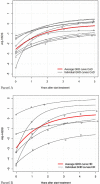Catch-up Growth in Prepubertal Children Treated for Juvenile Hypothyroidism and Growth Hormone Deficiency can be Modelled with a Monomolecular Function
- PMID: 32936765
- PMCID: PMC7947729
- DOI: 10.4274/jcrpe.galenos.2020.2020.0130
Catch-up Growth in Prepubertal Children Treated for Juvenile Hypothyroidism and Growth Hormone Deficiency can be Modelled with a Monomolecular Function
Abstract
Objective: We hypothesized that modelling catch-up growth (CUG) as developed for coeliac disease (CD), might also fit CUG in adequately treated children with juvenile hypothyroidism (JHT) or growth hormone deficiency (GHD).
Methods: We used a monomolecular function for all available prepubertal data on height standard deviation score (HSDS) minus target height SDS (adjHSDS) in children with JHT (n=20) and GHD (n=18) on a conventional (CoD) or high GH dose (HD), based either on a national height reference with an age cut-off of 10 (girls) and 12 (boys) years (model 1) or prepubertal height reference values, if age (0) was ≥3, with no upper age limit (model 2).
Results: The models could be fitted in 83-90% of cases; in other cases the HSDS decreased after several measurements, which violated the assumption of an irreversible growth process. In JHT, the rate constant (k) and adjHSDS (0) were lower than in CD (p=0.02), but adjHSDS (end) was similar. In GHD (model 1), k was lower than for CD (p=0.004) but similar to JHT, while adjHSDS (0) and adjHSDS (end) were similar to CD and JHT. Thus, the shape of CUG is similar for children with JHT and GHD, while children with CD had less growth deficit at start and a faster CUG. The differences in CUG parameters between GH dose subgroups did not reach statistical significance.
Conclusion: Modelling CUG of prepubertal children with JHT and GHD can be used for assessing the adequacy of CUG and the influence of clinical treatment modalities on its speed and magnitude.
Keywords: Growth; catch-up growth; coeliac disease; growth hormone deficiency; hypothyroidism.
Figures






Similar articles
-
Growth hormone treatment in prepubertal children with celiac disease and growth hormone deficiency.J Pediatr Gastroenterol Nutr. 2007 Oct;45(4):433-7. doi: 10.1097/MPG.0b013e3180de5e0a. J Pediatr Gastroenterol Nutr. 2007. PMID: 18030209 Clinical Trial.
-
Catch-up growth after childhood-onset substitution in primary hypothyroidism: is it a guide towards optimal growth hormone treatment in idiopathic growth hormone deficiency?Horm Res. 1998;50(5):264-70. doi: 10.1159/000023288. Horm Res. 1998. PMID: 9873194 Clinical Trial.
-
Effect of adherence to growth hormone treatment on 0-2 year catch-up growth in children with growth hormone deficiency.PLoS One. 2018 Oct 24;13(10):e0206009. doi: 10.1371/journal.pone.0206009. eCollection 2018. PLoS One. 2018. PMID: 30356273 Free PMC article.
-
Short stature in children with coeliac disease.Pediatr Endocrinol Rev. 2009 Jun;6(4):457-63. Pediatr Endocrinol Rev. 2009. PMID: 19550380 Review.
-
The growth hormone cascade: progress and long-term results of growth hormone treatment in growth hormone deficiency.Horm Res. 1998;49 Suppl 2:41-57. doi: 10.1159/000053087. Horm Res. 1998. PMID: 9730672 Review.
Cited by
-
Short and Long-Term Effects of Growth Hormone in Children and Adolescents With GH Deficiency.Front Endocrinol (Lausanne). 2021 Sep 1;12:720419. doi: 10.3389/fendo.2021.720419. eCollection 2021. Front Endocrinol (Lausanne). 2021. PMID: 34539573 Free PMC article. Review.
References
-
- Prader A, Tanner JM, Von Harnack GA. Catch-up growth following illness or starvation. An example of developmental canalization in man. J Pediatr. 1963;62:646–659. - PubMed
-
- Tanner JM. Catch-up growth in man. Br Med Bull. 1981;37:233–238. - PubMed
-
- Boersma B, Wit JM. Catch-up growth. Endocr Rev. 1997;18:646–661. - PubMed
-
- Jelenkovic A, Ortega-Alonso A, Rose RJ, Kaprio J, Rebato E, Silventoinen K. Genetic and environmental influences on growth from late childhood to adulthood: a longitudinal study of two Finnish twin cohorts. Am J Hum Biol. 2011;23:764–773. - PubMed
-
- Rivkees SA, Bode HH, Crawford JD. Long-term growth in juvenile acquired hypothyroidism: the failure to achieve normal adult stature. N Engl J Med. 1988;318:599–602. - PubMed
MeSH terms
Substances
LinkOut - more resources
Full Text Sources
Other Literature Sources
Medical
